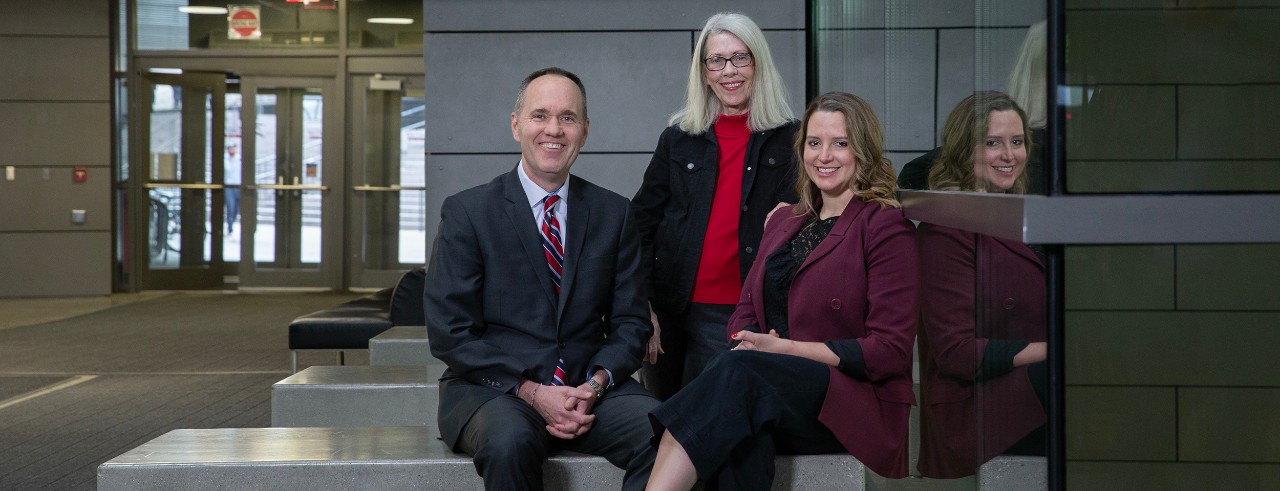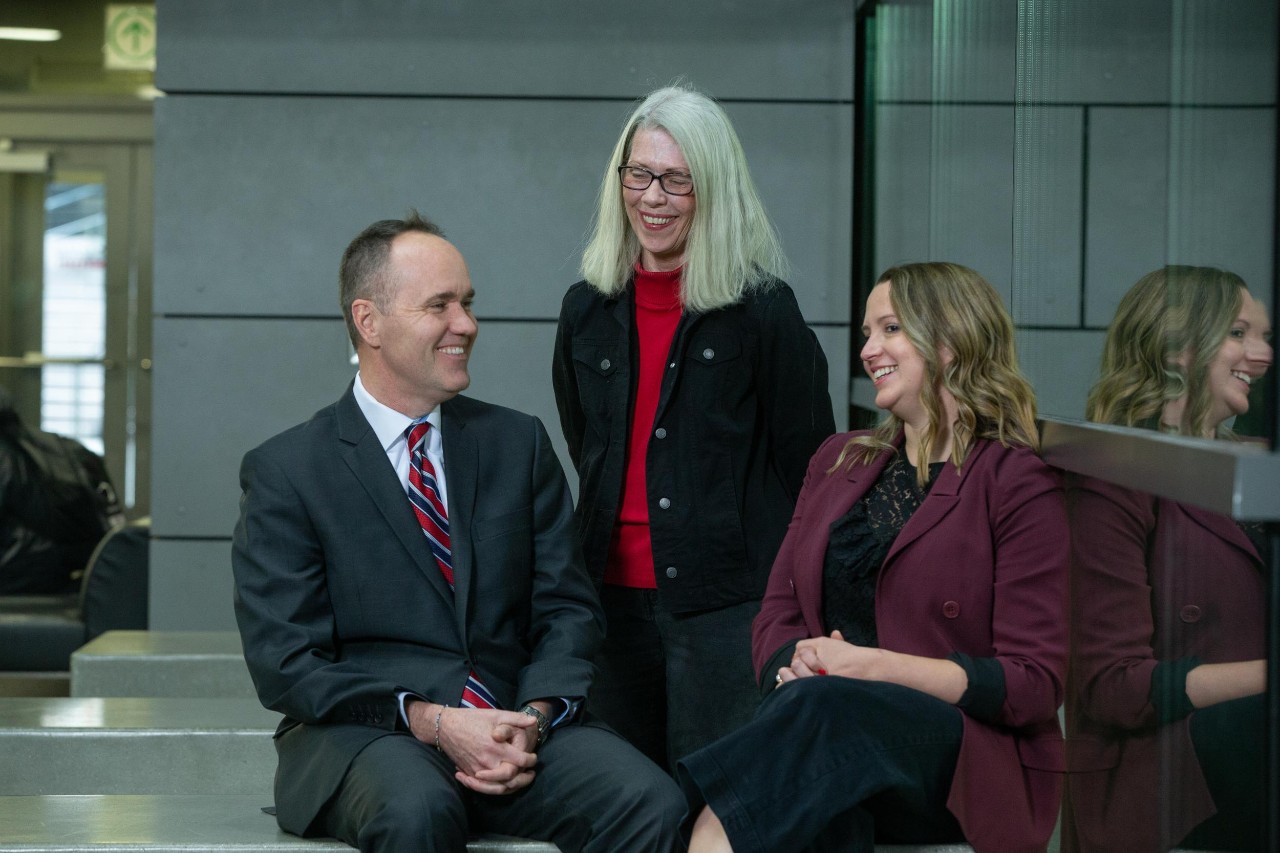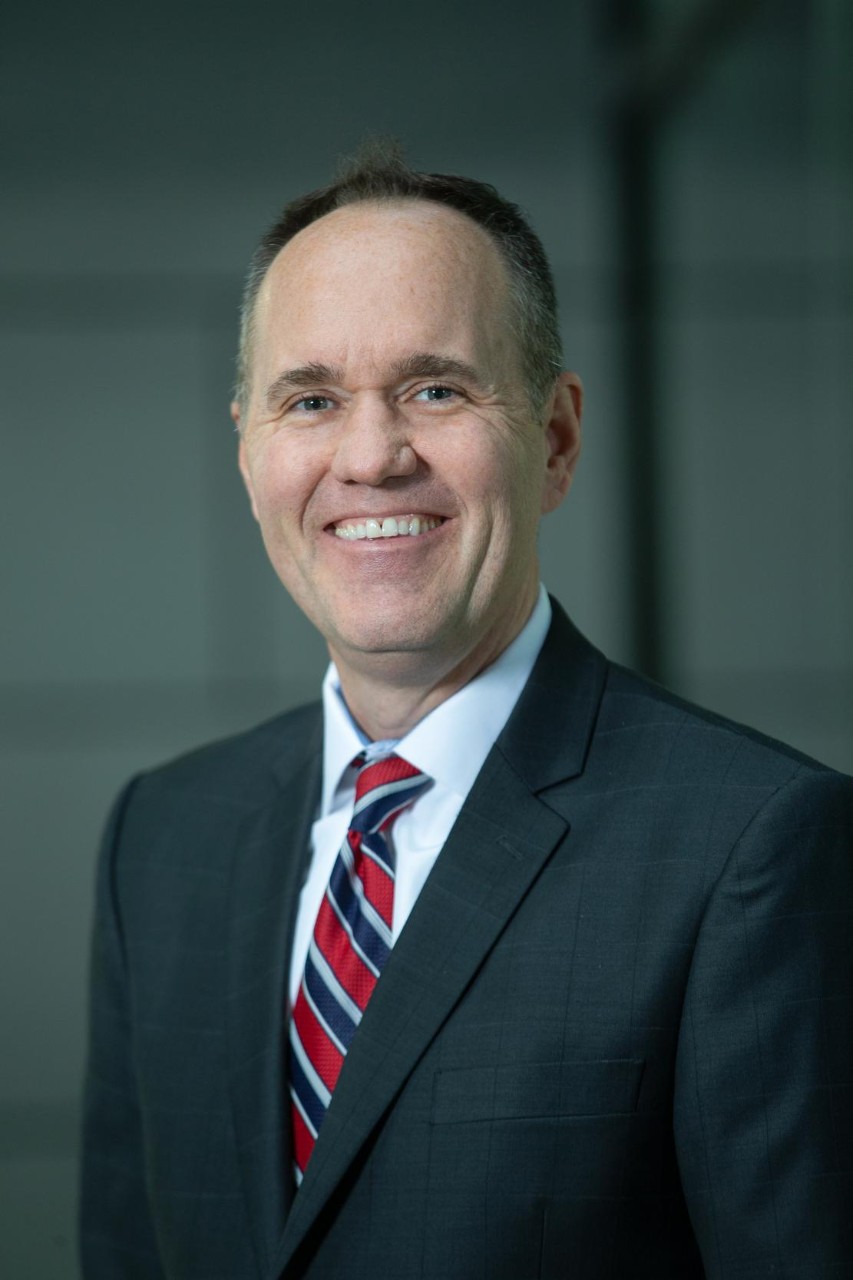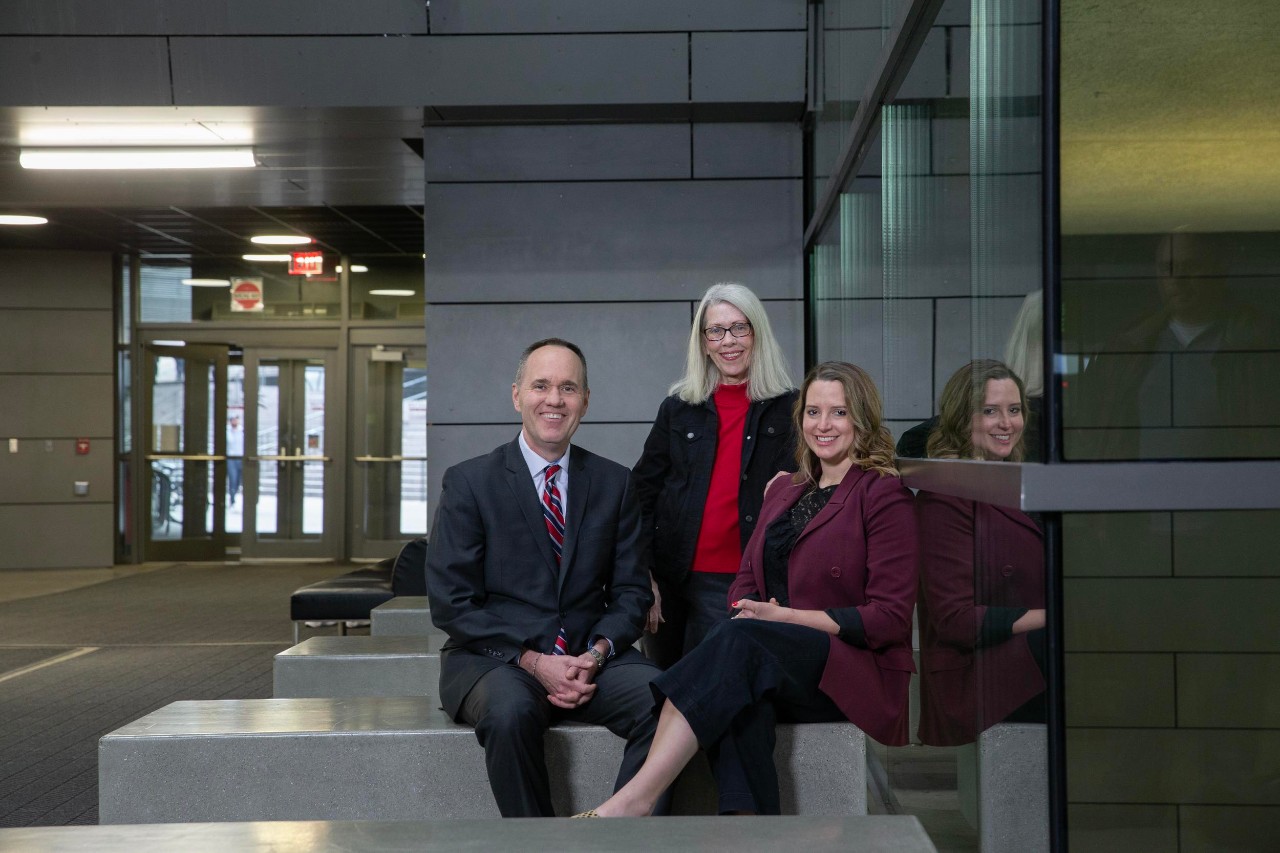
The future of work: How should we view work-life balance?
UC business professors, staff discuss setting boundaries, avoiding burnout
The COVID-19 pandemic, an increase in remote work and other disruptions to the way people work have led many employers and employees to reconsider issues surrounding work-life balance.
Two professors and a staff member from the University of Cincinnati's Carl H. Lindner College of Business discuss how employees and employers can take steps to improve work-life balance, how paid time off should be handled and the potential for a four-day workweek.
The experts are:
- Kevin Hardy, assistant dean and the Karen Bennett Hoeb Director of Cooperative Education, Lindner Career Services
- Elaine Hollensbe, PhD, department head and professor of management, Department of Management
- Laurens Steed, PhD, assistant professor, Department of Management

From left, Kevin Hardy, Elaine Hollensbe and Laurens Steed. Photo/Andrew Higley/UC Marketing + Brand
Why is work-life balance important?
Steed: From an employee standpoint, we have evidence that going home and recovering from work is good for your sleep, mental well-being and job performance. It's good for the employee both physiologically and for their productivity in the workplace. I think for employers, it's important to prioritize employees having the ability to disconnect from work so they have some of those benefits.
Hollensbe: People have different definitions of what work-life balance means, and that's an important thing to consider. For example, there's a certain group of people who really like to keep those areas of their life separate. They've almost erected a boundary between their work and home. There are other people who are quite comfortable having work and home just mix, and they're integrators. They don't need a separation.
Steed: I've seen people start to use the terms work-life integration versus work-life balance where they're talking about how you fit your work into your life rather than viewing the two things as opposed to each other. The pandemic changed a lot of that. For a lot of people, your work was in your living room or your basement so it was a lot harder to have distinct lines between work and life.
Hollensbe: Most people really do find it stressful to not have some segmentation. There are many more segmentors than integrators in the world.
The future of work series
Learn more from UC's business experts:
How do employees ensure they are maintaining a proper work-life balance?
Steed: Some of this depends on the person. People can be more of a segmentor or [more of an] integrator. Neither is good or bad, but people can find themselves on different sides of the spectrum. Some of this is knowing your personal preferences and working to maintain boundaries that align with them.
Hollensbe: A really important thing that we've found is communicating those preferences. If you prefer to have things separate, and you're in a position where you can make that clear to people, it's important to do so and to communicate the expectations that you have. Your expectations of work-life balance may be different than your employer's. And that sometimes suggests a poor fit. If there are organizations that really require people to be available 24/7, and you like to segment that part of your life, that's a problem. To ensure work-life balance, be aware of what your preferences are, communicate those preferences and find a workplace that values the same kind of separation that you do.
Hardy: What employers are doing, and good managers are trying to do, is to put what I would call “fail-safes” in place, so if they see employees that are working lots of hours, they are telling them, “Hey, it’s OK. This can wait.” Or prioritize one thing over another.
What COVID has taught us is that anything is possible. We used to say, “We're going to be here Monday through Friday, 8 to 5, this is the way we do business.” [COVID] forced us to say, “Well, now you've got to work in a different way.” For the most part, many organizations did it, they thrived, and they could figure it out. To keep employees, especially right now when it is an employee-friendly job market, companies are going to try anything. If that's what this person wants, let's look into it. And they're saying that some of the people are more productive.
How has the increase in remote work affected how people view work-life balance?

Kevin Hardy, assistant dean and the Karen Bennett Hoeb Director of Cooperative Education, Lindner Career Services
Hardy: Remote work was a situation where it was hard for people to turn the computer off. They felt like it was always there, and personally I still feel that way. I work more hours when I tend to work from home.
Hollensbe: It certainly eliminates things like commute time. Personally, I gained two hours. It sometimes takes me an hour to get home. I found myself having more time for personal things. I started an exercise regimen. I wasn't alone in that. People I've spoken with have chosen to do something they've never done before like hobbies, going for walks or learning a new thing like cooking. I think there are other people who are workaholic oriented and decide, “I’ve got two more hours to work.” Some of it is the individual’s preference.
Steed: I've heard of people, especially during the height of COVID, realizing they actually missed their commute. For example, maybe they drive in, and that's when they switch their head from home life to work life, and they always listen to a specific radio program. People started to do things to simulate a commute. Maybe I go for a quick walk and listen to my radio program, and then I sit down and start the day. Or setting other routines that signal that transition. I think some of that goes back to that segmentation preference. If you're a segmentor, that transition was probably harder for you than people who have no problem with that fluidity between their lives. I think it helps if people can put in structures and routines to signal those transitions between work and home, particularly if they like to keep those domains separate.
Hollensbe: I have a friend who had a system where when he would go to work in the morning, he would kiss the kids goodbye then he would go upstairs and close the door. His kids honored the boundary, which is actually a physical boundary between home and work that he erected.
Should employees be expected to respond to work calls or emails outside of their normal working hours?
Hollensbe: The expectation that employees should always be available is detrimental. There are some organizations and companies that think employees are always on when they can work at home. So what would traditionally be an off time becomes an on time. During COVID, there were a lot of offenders who called or emailed during off hours, and that's detrimental to people. It's detrimental not only to work-life balance but also to employee well-being and their job performance.
Steed: A lot of this comes from your company. If you're a segmentor and your boss is emailing you all night long, there's only so much you can do. A lot of these decisions and norms are set by the leaders and by the company culture, which has a lot to do with whether employees are able to kind of achieve the type of balance they want. I think that depends on the job and the expectations that you have going into the job. Some jobs are client-focused. If your clients need you at 11 p.m., and the expectation is that you have to respond, then you likely have to respond.
Hollensbe: It's really more of the nature of the job. With some positions, obviously, employees are on call. For example, there are health care workers who are on call; that's part of their job expectations.
Steed: There's no one-size-fits-all. Some jobs it's easy to draw those lines and contain work within the workday, and some jobs don't work like that. Some of it is setting those expectations for potential employees in the beginning as you're hiring, as you're recruiting.
Hollensbe: I have a friend who did a study of organizations that have expectations for accessibility after work, [for example] we can email you in the evening, email you any time. That actually created emotional exhaustion in people. It wasn't just having to address the email, but it was this anticipatory stress where they needed to be on red alert for an email coming in. For segmentors that was especially problematic. Her study was really interesting because it was this idea of expecting that I might get an email, not necessarily getting the email, that caused this angst and emotional exhaustion in people. And then they're not good employees if they're emotionally exhausted and burned out.
Steed: I've seen something recently in personal emails that I've really liked. They have a little thread at the bottom that said, “I am sending this email now, but my working time may differ from your working time. Do not feel obligated to respond immediately.” Or being really thoughtful, if you're a manager, it's 7 p.m., and something pops into your head, and this is a great time for you to send that email, you can communicate to your employees, “Hey, I don't need a response until tomorrow.” Otherwise people will feel obligated to respond when it's something that may not actually be urgent.
Hardy: Probably the biggest thing that people need to do if they’re falling victim, “Hey, my hours are 8 to 5, but they keep asking me to do things at 5:30, 6,” is [to take advantage of] numerous online resources via LinkedIn. Anyone who needs help with setting boundaries with their coworkers or with their supervisor should look at some of those resources to help coach them through what they should say.
How can people avoid burnout?

Elaine Hollensbe, PhD, department head and professor of management, Department of Management
Hollensbe: There's a theory in management called cognitive resources theory, meaning you only have so many resources. If those are depleted, you're not going to be any good to anybody. Burnout is a situation where you've depleted all of your resources. You can't think any more. Cognitive resources theory would suggest you need ways to replenish those resources. Maybe it's a respite. Maybe it's taking time and going somewhere with your family or going to a place where you've got some solitude. Maybe it's [finding] time for a hobby.
Steed: One thing about the pandemic is it brought employee well-being, time off and employee burnout to the forefront of discussions within companies. Employers realized they had to start prioritizing employee well-being more.
Hollensbe: You can help identify what schedule would work best for you. Maybe we don't just slam you into a schedule and then change your schedule every week. Maybe we give you a consistent set of hours and try to work around that. For example, somebody working in a grocery store may have one week when they work the morning shift; the next week they're closing and the next week they have to work Saturday. Those are disruptive to somebody's work-life balance. Creating consistent schedules is something that could be done for these kinds of workers.
Steed: There's a book I love by Dr. Leslie Perlow called “Sleeping with Your Smartphone.” She did a study at Boston Consulting Group, a very elite consulting firm where they work all the time. She implemented a program called “Predictable Time Off,” where they basically forced at least one employee on the team to take a day off. They actually found that it helped the team all together. It helped people to spend more time with their families or doing things they wanted to do in their personal lives. They also had to communicate to do that. If I know I'm not working tomorrow and you're on my team, I'm going to tell you, “Hey, here's what you might expect to hear from the client or here's what work you might see coming through the pipeline.” So it actually led to better communication within the team and improved perceptions of work-life balance.
Hollensbe: It will mean convincing managers who really do measure productivity and think productivity is the end-all and be-all of companies. I think it's also going to take recognition that well-being is an outcome that people need. Even if your objective is making profits and being productive, the path there is to treat people like human beings and recognize that they have a life outside of work.
How should paid time off be viewed in the United States, where workers tend to have less PTO than their counterparts in Europe?
Steed: I think paid time off is extremely important for employees and for employee well-being. The way that Europe does it, I don't see that happening in the United States. I think what we can do in the system is encourage employees to take the time off, offer the time off as an employer and prioritize that people take it. There's some level of not just offering the PTO but making sure people take it. That comes from modeling at the top. Have leaders take time off and respect time off. Giving people predictable and respected time off is important.
Hollensbe: It is pretty astounding because I'll get students in my classes who are from Europe and they'll talk about the benefits packages, the vacation and time off, and our American students' jaws just drop because they're lucky if they get a week of time off. Then there are these people who are young in entry positions and have a month of holiday. There is a big difference in PTO between many jobs in the United States and many jobs in Europe.
Hardy: There are companies, mostly technology companies out in San Francisco or that area, that are coming out with unlimited vacation time. But what they have also seen with places that have unlimited vacation time, those people use it less. Even though they have as much vacation as they want, they use less than people who are given two or three weeks of vacation. Companies provide benefits that are flashy in the news because, “Oh, we have unlimited vacation.” But yet, are people mandating that people take their vacation? We need to do better as companies in encouraging vacation or mandatory vacation time. I think that's the thing that will happen. I don't think a lot of companies are going to offer more.
Hollensbe: Some companies have gone to a system where they use PTO and everything goes into this pool. It's not just vacation, but it's sick leave, it's personal days. Increasingly companies are looking at that as an option for a couple reasons. It gives people more latitude; they don't have to disclose that they're having a mental health day; they can just say I'm taking a PTO day. So it provides discretion, flexibility and control to employees. It also eliminates the need for employers to police that. A disadvantage is that when you offer a block of PTO time, sometimes employees use it as vacation, and then when they're sick, they come to work sick because they've exhausted all their PTO days.
How has the COVID-19 pandemic changed how sick time is viewed?

Laurens Steed, PhD, assistant professor, Department of Management
Steed: I think it has shifted how all of us think about being sick. I think it's shifted a mindset from the ideal worker [would] push through and come to work sick, to realizing coming to work sick has implications for the people around you, your team and your coworkers. Yes, you're here doing this work, but you're also putting me at risk of getting sick, which is really disruptive for us as a team or me as an individual. At least anecdotally it seems it's shifted a mindset where you realize the cost of coming to work sick can be higher for the people around you than the benefit. And we've now shown many jobs can be done remotely. Not all of them can, but in jobs that can be done remotely, it doesn't make sense to put other people at risk. Or at least wearing masks. I'm now much more likely if I have to be somewhere and I don't feel well, can I wear a mask to at least be respectful to the people around me and maybe not spread my germs.
Hardy: We've seen people who are saying, “I used to be able to take off when I was sick.” Now it's, “I know the team's working. I know I've got things that need to be done. I can kind of [work] through it and get some of these things done.” I think it's a communication thing with your staff. We have to be able to say, “When you are sick, you need to take that day.” I think the biggest thing is the communication on am I truly off on my sick days, am I truly off on my vacation days. Whether you're working in person or you're working remote, it makes no difference.
Hollensbe: It's really kind of blurred what it means to take a sick day. If I am working at home and sick, do I tell them I'm sick? Will it look like I'm taking advantage of the fact that I'm working at home? I think people fear taking sick time because they don't want to be seen as taking advantage of it, but there's really a cost associated with coming to work or working at home even while sick. They call it “presenteeism” when you work while you're sick. [If] you work when you're sick instead of taking a sick day, you’re going to be less productive, you're probably going to get sicker, and you're going to need to take another sick day at a later time.
Steed: I do think that it is harder to take a completely disconnected sick day. You can think, “I'll get online even though I'm not well.” And a lot of these decisions are more system decisions. What is the organization like? What kind of policies do they set? What expectations do managers set? Can you set an expectation among your employees that if you are truly ill, take the sick day, stay home and recover because you're not going to get better if you're working rather than resting and doing the things you need to do to take care of yourself?
Hardy: Unless it's laid out clearly, there's going to be people that are going to say, “I feel guilty even though I'm sick that I'm not working.” It's those people that are going to be the ones burning out.
How should parental leave be viewed?
Steed: Parental leave is really important for employees and society to help people be better, healthier families. It's a shame that we don't have more of that in the United States.
Parental leave attracts employees, and it also retains employees. If you have great employees who have a child, and they're able to take time off to recover from that experience and bond with the child and then come back when they're ready, you have a greater chance of that good employee staying with your company. In the life of an employee, and the amount of time you hope to retain good employees, three months or four months is a blip of time. That's nothing. But in the life of a person with a new baby, that's a really huge benefit.

From left, Kevin Hardy, Elaine Hollensbe and Laurens Steed. Photo/Andrew Higley/UC Marketing + Brand
Is a four-day workweek going to become common in the future?
Hollensbe: When we say we are going to a four-day workweek, the way I look at that is not working 40 hours in four days. It's working 32 hours and getting the same amount of work accomplished. I think it's very attractive, and I think most U.S. adults would think that's very attractive. But more study is needed. I saw one study where they went to this 32-hour, four-day week. They weren't able to document that productivity was the same or equivalent and so the plan was nixed. What it will take is convincing managers that they're going to get equivalent productivity from somebody who is working 32 hours over four days versus 40 hours over five days. I don't think it's a stretch to believe that. If somebody is focused, and they know that they need to get the work done in a shorter time, there are probably ways that they can flex their work. But, again, the proof is in the pudding, and I think studies are what's going to be needed to get organizations to buy in.
Steed: There was a big pilot [study] I saw in London, and it seemed the data that came out of it was pretty positive. Productivity stayed high, and employee burnout went down. I think there are interesting ways to do it, too. It doesn't have to be, “Everyone works Monday through Thursday, and we're closed Friday to Sunday.” Perhaps you could have some employees [working] Tuesday to Friday, and some employees Monday to Thursday. You can stagger those days off where you have coverage and the office can remain open, but you still allow employees to have those shorter workweeks.
Hardy: What I like about right now with employees being in control is it's a great time to explore. It's a great time to explore what's working and what isn't, and let's give it a shot. We could figure out, in the same way we figured out many employees love the flexibility of a hybrid schedule, we're going to figure out if they like four or five days.
Could some companies continue to have their employees work 40 hours a week while moving to a four-day workweek?
Hollensbe: I think there are health care workers, some nurses for example, who have that schedule which is a compressed workweek. The positive is you do get that extra day. The negative is you get pretty exhausted working a 10-hour workday, especially when you're on your feet like a nurse is. Are you as responsive to patients or customers after being on your feet for eight hours and you've got another two to go? There are some studies that have suggested that's a good thing. Some have suggested an alternative because of the burnout factor. Some of that depends on the intensity of the work.
What is the future of movements like $15-an-hour minimum wage?
Hardy: It's definitely going to happen. I don't see any changes to $15 an hour or being in that range until we get some sort of easement on what's taking place with inflation. As long as you're paying $4 for eggs, you're going to be seeing $15 an hour. You could even see it higher.
Hollensbe: Several states, cities and counties have increased the minimum wage recently, and that's been attributed to things like inflation but also recognition that these customer-facing people are doing something that we consider essential. It brings people out of poverty. And if you have somebody who can now feed their family, their morale is going to be better. It's going to increase how much they spend. It's going to help our economy. There are lots of reasons why you can argue increasing the minimum wage would be a positive thing. The pushback is that if a small business has to pay $15 an hour, how are they going to survive? Their biggest expense is labor, and now you're going to tack on an additional surcharge for them to have to pay $15 an hour.
Want to learn more about the future of work? UC experts weighed in on the future of remote work, in-person work and engaging employees.
Featured image at top: From left, Kevin Hardy, Elaine Hollensbe and Laurens Steed. Photo/Andrew Higley/UC Marketing + Brand
Impact Lives Here
The University of Cincinnati is leading public urban universities into a new era of innovation and impact. Our faculty, staff and students are saving lives, changing outcomes and bending the future in our city's direction. Next Lives Here.
Related Stories
The future of work: How should we view work-life balance?
February 7, 2023
The COVID-19 pandemic, an increase in remote work and other disruptions to the way people work have led many employers and employees to reconsider issues surrounding work-life balance. Two professors and a staff member from the University of Cincinnati's Carl H. Lindner College of Business discuss how employees and employers can take steps to improve work-life balance, how paid time off should be handled and the potential for a four-day workweek.
The future of work: What’s the future of in-person work?
September 29, 2022
While office buildings traditionally have been at the center of work for many people, factors including the COVID-19 pandemic have forced employers to reconsider the look of their workspaces.
The future of work: How can employers engage employees?
December 1, 2022
With unemployment rates throughout the United States near 50-year lows, American companies have reported difficulties in hiring and retaining employees. Three professors and a staff member from the University of Cincinnati's Carl H. Lindner College of Business discuss how employees can attract potential employees, how they can keep their current employees engaged with their work and shifts in employee engagement trends.
